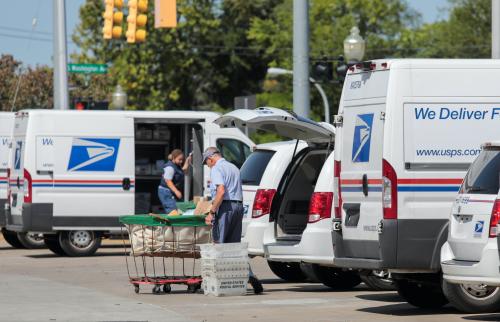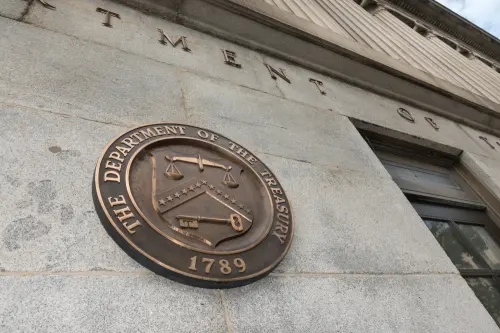The United States Postal Service (USPS) is big. It employs over 600,000; only two private employers (Amazon and Walmart) employ more people. It serves 160 million homes, businesses, and other delivery points. It would have ranked number 44 on the 2019 Fortune 500 if it were included. The COVID-19 pandemic has severely threatened demand and revenue for USPS, straining its already fragile finances. As the financial standing of the Postal Service makes headlines, we examine how it is set up, what financial challenges it faces, and how it is managing these challenges during a global pandemic.
How is the Postal Service governed?
The Second Continental Congress appointed Benjamin Franklin as the first Postmaster General in 1775. The Post Office Department was created in 1792 and became a Cabinet department in 1872. In 1971, Congress replaced the Department with the United States Postal Service, an independent entity within the executive branch. USPS is operated by a 11-person Board of Governors (which resembles the board of directors of a public corporation)—the Postmaster General, his deputy (currently vacant), and nine governors appointed by the President and approved by the Senate for seven-year terms. All six of the current independent governors were appointed by President Trump; three slots are empty. The Board appoints the Postmaster General, who acts as the CEO.
A separate Postal Regulatory Commission with five members appointed by the President and confirmed by the Senate oversees the USPS, including the rates it charges.
How is the Postal Service financed?
The Postal Service receives no direct taxpayer funds. It relies on revenues from stamps and other service fees. Although COVID-19 has choked off the USPS revenue in recent months, factors that arose well before coronavirus have contributed to the unsustainability of the Postal Service’s financial situation for years.
What are the long-term problems with how the Postal Service is financed?
The fundamental problem is that while the USPS generates enough revenue to cover its operating costs, its pension and retiree health care liabilities push its bottom line into the red. The USPS has operated at a loss since 2007. From 2008 to 2018, it reported $69 billion in losses. For the 2019 fiscal year, it lost $8.8 billion on $71.1 billion of operating revenue.
Because of the rise of email and digital communication, USPS has seen the volume of First-Class Mail decline from a peak of 103.5 billion pieces in 2000 to just shy of 55 billion pieces in 2019. USPS has tried to increase the delivery of marketing mail and has tried to compete with UPS and FedEx in the parcel delivery sector, including by forging a delivery deal with Amazon. (This has provoked criticism from President Trump.) As of 2017, the USPS held a market share of over 19 percent in U.S. package delivery. By law, the Postal Service has an obligation to provide universal service—that is, to deliver mail to “as nearly as practicable the entire population of the United States.” This forces USPS to deliver to more addresses each year, even as fewer pieces of mail are being delivered.
As First-Class Mail volumes have declined, the USPS has been reducing the number of blue mailboxes for years. It currently has 140,837 of them, down from 164,099 in 2013.
What is the issue with USPS retiree health benefits?
Beyond operational challenges, the other drag on the finances of the USPS is the Postal Service Retiree Health Benefits Fund. Like many employers, the Postal Service provides pensions for its retired employees—and it is required, as private companies are, to set aside money from current income to cover its pension promises.
In addition, USPS provides health benefits to its retirees, as other government employers—but not all large private employers—do. Unlike other employers, though, the USPS is required by the Postal Accountability and Enhancement Act (PAEA) of 2006 to pre-fund retiree health costs out of current income. The unique drag on the Postal Service comes from this congressional requirement.
In 2002, the Office of Personnel Management found that the Postal Service had been significantly over-paying into its pension fund, leaving it with cash beyond what was needed to meet its employee retirement liabilities. Combined with strong performance in the early 2000s, this unexpected windfall positioned USPS to catch up on the pre-funding of its retirement health benefit obligations after years of a “pay-as-you-go” approach before the passage of PAEA. In that law, Congress instructed USPS to contribute approximately $5.6 billion per year from 2007 to 2016 and to stretch any additional obligations over the almost 40 years from 2017 to 2056.
Shortly after the requirements were passed, the economy sank into the Great Recession and digital competition intensified, driving down revenues. As a result, USPS has missed $42.6 billion of required payments on its health benefits since 2010 and $5.6 billion in required contributions to its pension plan since 2014.
What strains has the COVID-19 pandemic put on the finances of the Postal Service?
Provisions of personal protective equipment to employees, a decrease in the ability to use air transportation for deliveries, increased paid sick leave, and low customer demand have all contributed to surging costs and declining revenues. Package shipping revenues in the second quarter surged by 53.6 percent over the second quarter of 2019, which kept the USPS net loss to $2.2 billion for the quarter compared to a loss of $2.3 billion a year earlier. Increases in volume for packages are not expected to make up for continued weakness in marketing mail volume (down 37.2 percent, year over year) and First-Class mail volume (down 6.4 percent) as the pandemic continues.
What has Congress done to support the Postal Service?
In the CARES Act, Congress provided a $10 billion emergency loan to the USPS. The loan is sufficient to cover immediate cash needs for the Postal Service, according to the agency’s 2020Q3 Fiscal Report. The conditions that the Treasury imposed on the loan led the vice chairman of the USPS board, David Williams, a former USPS inspector general, to resign, alleging that the Treasury demands threatened to turn the agency into a “political tool.”
The loan postpones, rather than solves, the USPS looming liquidity crisis. The House of Representatives passed a bill on August 22 to provide $25 billion in additional government funding to the Postal Service. In addition, the bill—which is unlikely to pass the Senate—mandates that the USPS must reverse any policy changes that have led to delays in mail delivery and refrain from any new policies that would reduce its mail delivery performance until the end of the COVID-19 public health emergency.
What steps has Postmaster General Louis DeJoy taken since taking office in June 2020?
In April 2018, President Trump created the Task Force on the United States Postal Service, chaired by Treasury Secretary Steve Mnuchin. The Task Force produced a report in December 2018, urging cost-cutting and price increases. The New York Times reported that Mnuchin was unusually involved in the Postmaster General recruitment process, with Postal Service Board Chairman Robert M. Duncan, a former chairman of the Republican National Committee, suggesting Louis DeJoy, who has a background in the logistics business.
Cost-cutting efforts at the USPS were already underway when DeJoy was sworn in as Postmaster General in June 2020. However, combined with President Trump’s comments questioning the security of mail-in voting, changes to Postal Service operation—some of which were in train before DeJoy’s appointment—have been particularly controversial. Internal memos outline new policies to avoid late departures and extra delivery trips, even if it means that “we may see mail left behind or mail on the workroom floor or docks.”
In August 2020 testimony to the House Committee on Oversight and Reform, DeJoy said he didn’t explicitly order the practices that have generated criticism: “First, I did not direct the removal of blue collection boxes or the removal of mail processing equipment. Second, I did not direct the cut back on hours at any of our post offices. Finally, I did not direct the elimination or any cutback in overtime.” Nevertheless, on August 18, DeJoy committed to suspending his long-term reform initiatives until after the November election. He promised that there would be no changes to Postal Service retail hours, that collection boxes and processing equipment will remain where they are (though no commitment was made to return boxes and equipment already removed), and that overtime hours would be granted to employees as necessary.
The Brookings Institution is committed to quality, independence, and impact.
We are supported by a diverse array of funders. In line with our values and policies, each Brookings publication represents the sole views of its author(s).







Commentary
How is the U.S. Postal Service governed and funded?
August 26, 2020